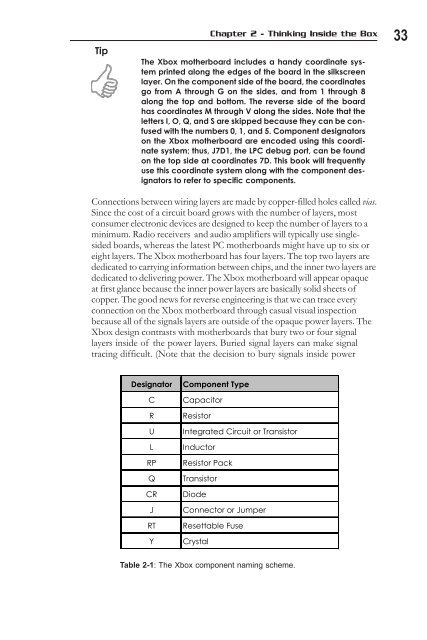Hacking the Xbox
Hacking the Xbox
Hacking the Xbox
Create successful ePaper yourself
Turn your PDF publications into a flip-book with our unique Google optimized e-Paper software.
Tip<br />
Chapter 2 - Thinking Inside <strong>the</strong> Box 33<br />
The <strong>Xbox</strong> mo<strong>the</strong>rboard includes a handy coordinate system<br />
printed along <strong>the</strong> edges of <strong>the</strong> board in <strong>the</strong> silkscreen<br />
layer. On <strong>the</strong> component side of <strong>the</strong> board, <strong>the</strong> coordinates<br />
go from A through G on <strong>the</strong> sides, and from 1 through 8<br />
along <strong>the</strong> top and bottom. The reverse side of <strong>the</strong> board<br />
has coordinates M through V along <strong>the</strong> sides. Note that <strong>the</strong><br />
letters I, O, Q, and S are skipped because <strong>the</strong>y can be confused<br />
with <strong>the</strong> numbers 0, 1, and 5. Component designators<br />
on <strong>the</strong> <strong>Xbox</strong> mo<strong>the</strong>rboard are encoded using this coordinate<br />
system; thus, J7D1, <strong>the</strong> LPC debug port, can be found<br />
on <strong>the</strong> top side at coordinates 7D. This book will frequently<br />
use this coordinate system along with <strong>the</strong> component designators<br />
to refer to specific components.<br />
Connections between wiring layers are made by copper-filled holes called vias.<br />
Since <strong>the</strong> cost of a circuit board grows with <strong>the</strong> number of layers, most<br />
consumer electronic devices are designed to keep <strong>the</strong> number of layers to a<br />
minimum. Radio receivers and audio amplifiers will typically use singlesided<br />
boards, whereas <strong>the</strong> latest PC mo<strong>the</strong>rboards might have up to six or<br />
eight layers. The <strong>Xbox</strong> mo<strong>the</strong>rboard has four layers. The top two layers are<br />
dedicated to carrying information between chips, and <strong>the</strong> inner two layers are<br />
dedicated to delivering power. The <strong>Xbox</strong> mo<strong>the</strong>rboard will appear opaque<br />
at first glance because <strong>the</strong> inner power layers are basically solid sheets of<br />
copper. The good news for reverse engineering is that we can trace every<br />
connection on <strong>the</strong> <strong>Xbox</strong> mo<strong>the</strong>rboard through casual visual inspection<br />
because all of <strong>the</strong> signals layers are outside of <strong>the</strong> opaque power layers. The<br />
<strong>Xbox</strong> design contrasts with mo<strong>the</strong>rboards that bury two or four signal<br />
layers inside of <strong>the</strong> power layers. Buried signal layers can make signal<br />
tracing difficult. (Note that <strong>the</strong> decision to bury signals inside power<br />
Designator Component Type<br />
C Capacitor<br />
R Resistor<br />
U Integrated Circuit or Transistor<br />
L Inductor<br />
RP Resistor Pack<br />
Q Transistor<br />
CR Diode<br />
J Connector or Jumper<br />
RT Resettable Fuse<br />
Y Crystal<br />
Table 2-1: The <strong>Xbox</strong> component naming scheme.


